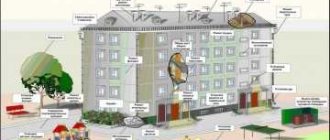Answer
The limit of operational responsibility is determined by agreement of the parties.
If an agreement cannot be reached, then the boundary is determined by the balance sheet boundary. Balance sheet ownership is determined by entries in the state register of rights and other documents in accordance with the law. As a rule, a section of the network within the land plot of the house owner is his property.
The rationale for this position is given below in the materials of the “Lawyer System”
.
"2. These Rules use the concepts defined in the Federal Law “On Water Supply and Sanitation”, as well as the following concepts:
“balance line of ownership” - the line of division of objects of centralized cold water supply and (or) wastewater disposal systems, including water supply and (or) sewerage networks, between owners on the basis of ownership or possession on another legal basis;
“limit of operational responsibility” - a line dividing objects of centralized cold water supply and (or) sewerage systems, including water supply and (or) sewerage networks, based on duties (responsibility) for the operation of these systems or networks, established in a cold water supply agreement, contract water disposal or a single agreement for cold water supply and sanitation, an agreement for the transportation of cold water, an agreement for the transportation of wastewater*.”
Understanding the boundaries of responsibility between the RSO, the management company and the owners of residential premises in apartment buildings is important to avoid controversial situations. In judicial practice, there are often cases of disputes between the RSO and the management company regarding operational responsibility for certain sections of utility networks, regarding which no agreement has been reached.
In half of administrative cases of this kind, the court takes the side of the RSO, in this case the Criminal Code incurs large losses. To avoid this and be insured against unwanted conflicts, you need to draw up an act of delimitation of responsibility.
Legal basis
The main goal of this document is to identify clear boundaries of organizations’ responsibilities. However, the legislation does not define exactly how these boundaries should be determined. That is why, in order to somehow understand this issue, it is recommended that you carefully read the regulatory documents.
Thus, the boundary that determines the belonging of a site to a specific organization is considered to be the node separating the owner’s network and the general network. If we consider the electrical network of an apartment in a multi-storey building, then a piece of wire running from the electric meter to the apartment is considered private property. The tenant himself is responsible for this. But the wire to the meter is on the balance sheet of the relevant organization. As a rule, the housing office is responsible for this section, and another organization is responsible for the high-voltage wire that approaches the transformer substation.
( Video : “Limits of operational responsibility for wastewater networks”)
As a rule, the parties must document existing boundaries by prior agreement. For these purposes, a corresponding act is drawn up. You may encounter a situation where the parties cannot reach a common opinion. This usually happens due to the fact that one party, usually the supplier, reduces its area of responsibility, increasing it on the client’s side. In such situations, the distinction is made through judicial proceedings.
You may encounter a situation where it is not possible to identify operational responsibilities. In this case, the balance sheet is determined, the border of which is located on the outside of the building. Although you need to understand, by mutual agreement of the parties it is allowed to indicate other boundaries in the act.
Goals and objectives of the act
The management company must outline clear responsibilities, defining which communications it is responsible for and which the resource company is responsible for.
In essence, this act allows you to regulate the relationship between the consumer and the supplier of gas, electricity, water and other resources. Different companies with different resources on their balance sheets bear certain responsibilities. It is the demarcation act that defines clear boundaries, defining where the responsibility of one supplier of biological resources ends and the powers of another begin. Thus, when identifying accidents, breakdowns and malfunctions on the line, you can accurately determine the company that should fix the problem.
Identifying clear boundaries of responsibility between organizations is a fairly important issue. As practice shows, this is relevant for homeowners' associations, housing cooperatives and other similar organizations. The importance of this issue is explained by the financial side. After all, the responsible organization is obliged to carry out repairs and maintenance of communications located on its site. Naturally, the company must fulfill such obligations only in cases where the breakdown does not relate to the property of the home owner.
Arbitrage practice
Perhaps the main argument in favor of the importance of discussing in detail the boundaries of operational responsibility in a resource supply agreement will come from examples from judicial practice.
The management organization filed a claim in court to declare the terms of the energy supply contracts invalid and for the obligation to transfer the heating networks to the area of responsibility of the RSO. The court refused to satisfy the claims, since the Criminal Code agreed on the boundaries of the balance sheet, accepting the disputed section of the networks for its maintenance (Resolution of May 23, 2012 in case No. A63-9362/2011).
The court may make a different decision if the boundaries of the balance sheet in the act are indicated differently than along the external wall of an apartment building or at the point of installation of the meter. In this case, the act of delimiting balance sheet ownership is invalid (Determination of the Supreme Arbitration Court of the Russian Federation dated June 26, 2012 N 6421/12 in case N A14-11374/2010).
When concluding the contract, disagreements arose between the parties regarding the limit of operational responsibility, since there was no act of delimitation of responsibility, the court decided to determine the limit of operational responsibility in accordance with the Rules for the maintenance of common property (Resolution of the Arbitration Court of the Central District of May 21, 2015 N F10-1143/2015 in case N A68 -2267/2014).
And according to the Resolution of the Federal Antimonopoly Service of Ukraine dated February 28, 2011 No. Ф09-443/11-С5, in a similar situation of the absence of an act of delimitation of responsibility , the court concluded that the line of operational responsibility should pass along the line of balance sheet ownership, in other words, along the line of division of utility networks between owners.
Limits of operational responsibility
Not for all corporate entities the legislation clearly defines the boundaries of operational responsibility and the balance sheet inextricably linked with it. These concepts are most clearly presented in clause 1 of the Rules for cold water supply and sanitation (Resolution of the Government of the Russian Federation No. 644).
According to this document, the boundary of the balance sheet is recognized as the boundary of the division of property. It, in turn, determines the boundary of operational responsibility, that is, it indicates who will bear the burden of maintaining the facility: the management organization, the RSO or the owners. The same can be said about other communal resources.
The boundary of the operational responsibility of the RSO, if we are talking about power supply, extends to the point of connection of the common house metering device with the electrical network included in the apartment building. The responsibility of the management company is the in-house power supply system and electrical devices, disconnecting devices for the apartment. The responsibility of residents is internal devices and devices after disconnecting devices in floor panels, meters in apartments.
Responsibility for heat supply is distributed as follows: RSO bears responsibility up to the point of connection of the common house metering device with the heating network included in the apartment building. The management company is responsible for the heating system risers, disconnecting devices on branches from the risers and for shut-off and control valves on the intra-apartment wiring. Residents' responsibility again begins inside their home, they are responsible for heating devices and for branches from the heating system risers after the shut-off and control valves.
The responsibility of the RSO, when it comes to water supply and sanitation, extends to the point of connection of the common house meter with the water supply network included in the apartment building. Management companies are required to monitor the condition of hot and cold water supply risers, shut-off devices on branches from risers and shut-off and control valves on intra-apartment wiring. The owners of premises in apartment buildings are responsible for the branches from the risers of the hot and cold water supply system after the shut-off and control valves, for the shut-off and control valves themselves and for the plumbing equipment in the apartments.
In a resource supply agreement, the balance sheet boundary separates utility networks, which are common property (Article 36 of the Housing Code of the Russian Federation), from other utility networks. Therefore, let us recall what applies to common property (Resolution of the Government of the Russian Federation No. 491, Article 36 of the Housing Code of the Russian Federation):
- premises in apartment buildings that are not parts of apartments and are intended to serve more than one residential/non-residential premises in the house;
- in-house engineering systems for cold and hot water supply, gas supply, heating and electricity supply.
The boundaries of operational responsibility can be external and internal. In the first case, they share the spheres of competence of the RSO and the management company (the external border of the wall of the apartment building), in the second - the management company and the owners (the internal border of the wall of the apartment building).
On the delimitation of zones of operational responsibility
Power supply:
Area of responsibility of the management company Area of responsibility of residents
Notes:
1. The limit of operational responsibility of electrical networks is the contacts of the circuit breaker for connecting the cable supplying the Owner’s premises in the floor panel (see the red line in the diagram).
2. The owner is allowed electrical power Рр = 10 kW at a voltage of 380/220 V.
3. The owner carries out the operation of electrical networks and electrical equipment of the apartment (premises) independently.
4. Regarding compliance with contractual amounts of electricity consumption, restrictions and shutdowns, the Owner can contact the district office of JSC Lenenergo. The Management Company and the Owner provide unimpeded access for representatives of Rostekhnadzor SZU and JSC Lenenergo to electrical networks and electrical equipment within their area of responsibility.
5. If the Owner violates the Rules for Electrical Installations, the Rules for the Technical Operation of Electrical Installations, etc., or the Owner fails to comply with the instructions of the authorized bodies, the Management Company has the right to assist these bodies in disconnecting the apartment (premises) from the ASU of the apartment building.
6. In case of damage to the power cable outside the apartment (premises) and used directly to supply electricity to this apartment (premises), the Management Company carries out repair and restoration work at the expense of the Owner.
Water supply:
Heat supply:
Drainage:
Notes:
1. The operation of individual metering devices for hot water supply, hot water supply (IPU) is carried out by specialized organizations at the expense of the Owner. Commissioning of the IPU is carried out on the basis of tripartite acts with the participation of the Owner, a specialized organization and the management company based on the application of the Owner and at his expense.
2. Verification of the IPU after the expiration of the verification interval is carried out in the prescribed manner by a specialized organization in accordance with the requirements of the technical documentation of the manufacturer of the IPU, at the expense of the Owner. IPU must be sealed. The operation of unsealed IPU is prohibited.
Ventilation:
Providing residential (non-residential) premises with natural ventilation is carried out by ventilation air ducts. The boundary of operational responsibility between the management company and the Owner is the introduction of the air duct into the room. Unauthorized narrowing of the design cross-section of ventilation air ducts is not allowed .
Floor distribution boards, risers for cold and hot water supply, heating and sewerage, as well as air ducts, are the common property of the owners of premises in an apartment building, and are in their common ownership.
Appendix No. 5
External limits of operational responsibility
If we are talking about the external boundary of utility networks that are part of the common property of an apartment building, then the boundary of operational responsibility between the RSO and the management company will be considered the external boundary of the wall of the house, and if there is a common house meter for a certain utility resource, the place where this common house meter connects with the corresponding engineering network included in the MKD.
Separately, it is worth mentioning the external border of the gas supply networks that are part of the general property of the apartment building. In this case, the boundary of operational responsibility between the RSO and the management company is the point of connection of the first shut-off device with the external gas distribution network.
Often the line of operational responsibility does not run along the wall of the house. Then, a fragment of a utility network located outside the outer wall, which, it would seem, formally belongs to the area of responsibility of the RSO, falls into the zone of the management company managing the apartment building. Its content threatens large losses, so you need to carefully approach the description of the boundaries of operational responsibility in the act of delineation of responsibility.
The case when the boundary of operational responsibility passes along the external valve can be considered controversial. This happens if the external section of the utility network is part of the common property . Then the RSO carries out maintenance of this utility network at a tariff approved by the owners of the premises in the apartment building. The duty of the management company is to offer such a tariff to the owners. Repairs, including emergency ones, are carried out at the expense of RSO.
What about ownerless utility networks ? That is, with such networks that are not on the balance sheet of either the management company or the RSO and are not part of the common property. Typically, such networks are transferred to municipal ownership. In turn, the local government body, within thirty days from the moment of identifying an ownerless utility network, is obliged to determine the distribution network whose utility networks are connected to the ownerless one (Clause 6 of Article 15 No. 190-FZ).
The Federal Tariff Service will have to include the costs of maintaining such a network in the RNO tariffs for further regulation. Until this is done, energy losses in this disputed section of the network, as well as repair work, are carried out at the expense of the management company in proportion to actual consumption.
RSO agreement: how to establish the boundary of operational responsibility
The issue of location of supply points for communal resources and the boundaries of operational responsibility is one of the most controversial when concluding an agreement between a service company and a resource supply organization (RSO). Often, RSOs strive to determine the delivery point as far as possible from the consumer. Of course, this is unprofitable for HOAs/housing societies/housing complexes/managerial companies as providers of public services, because they bear costs not only for the loss of resources, but also for the maintenance of this section of networks. How to correctly determine the boundaries of liability from a legal point of view?
WHERE ARE THE LIMITS OF OPERATIONAL LIABILITY BY LAW?
Engineering communications networks are the common property of a multi-unit apartment building if they are located inside the house and on a land plot that is part of the common property, and if they are intended to serve this house (clauses 5-7 and clauses “G”, clause 2 “ Rules for the maintenance of common property").
The boundary of the networks included in the common property, according to clause 8 of the “Rules for the maintenance of common property,” must run along the outer boundary of the wall of the house. In this case, the boundary of operational responsibility in the presence of a general house metering device is located at the point where the meter connects to the utility network. If the boundaries of a land plot, which are determined by state cadastral registration, do not coincide with the external border of an apartment building, and the engineering networks on this site serve only one house, then the boundary of operational responsibility is determined along the border of the specified land plot. Thus, it will coincide with the balance sheet boundary.
However, owners can enter into an agreement with the RSO, where they will designate other boundaries of operational responsibility. We emphasize that this is done exclusively by agreement of the owners. In this case, it is necessary to sign the relevant acts stating that the operational boundary will pass beyond the balance sheet boundary.
The exception is gas supply networks. The boundaries with them will be located at the junction of the first shut-off device with the external gas distribution network.
DOCUMENTS ON DIVISION OF OPERATIONAL RESPONSIBILITY: WHEN TO SIGN?
It is better for the utility service provider to indicate the boundaries of operational responsibility and sign the relevant acts at the stage of signing the contract with the RSO. This will help avoid many controversial situations in the future, since the area of responsibility of each party will be designated in advance.
WHAT TO DO IF RSO INSISTS ON OTHER LIMITS OF LIABILITY?
If, at the stage of concluding an agreement, RSO insists on different boundaries of operational responsibility than those indicated above, then there is no need to rush to sign demarcation acts.
First of all, it is necessary to refer to clause 8 of the “Rules for the maintenance of common property”, which indicates how, according to the law, the boundaries of responsibility should lie. If in this case, representatives of the resource supply company insist on a different distinction, then a protocol of disagreements on this point should be signed. In the document, it is also important to refer to clause 8 of the “Rules for the maintenance of common property”.
Judicial practice shows that the court takes the side of the utility provider and obliges the RSO to accept the limits of liability provided for by law.
WHAT TO DO IF RSO REFUSES TO SIGN THE PROTOCOL OF DISPUTES?
If the RSO refuses to sign a protocol of disagreement on the boundaries of operational responsibility or it was not indicated when concluding the contract, then if disagreements arise regarding the repair, maintenance or payment of losses in the disputed section of the network, they must be resolved in court.
Thus, in such proceedings, the Supreme Arbitration Court found that the line of operational responsibility runs along the balance sheet. In turn, the latter is established on the basis of ownership.
WHAT TO DO IF THE LIMITS OF LIABILITY IN THE AGREEMENT ARE NOT INDICATED BY LAW?
The utility service provider has the right to terminate the contract and conclude it on different terms. In this case, it is necessary to follow the termination procedure specified in the contract. If necessary, new terms of the contract can be defended in court.
WHAT TO DO IF THE AGREEMENT ESTABLISHES LIMITS OF LIABILITY THAT GO BEYOND THE COMMON PROPERTY?
First of all, it is necessary to check whether consent has been obtained from the owners to establish such boundaries. If consent to move the boundaries beyond the balance sheet was not obtained, then the court will decide to recognize this clause of the agreement as void. In this case, the costs for loss of resources or repair of disputed sections of networks will be borne by the RSO.
UNOWNED NETWORK AREAS: WHO MAINTAINS AND PAYS FOR THE LOSSES?
Situations often occur when accidents or losses of resources occur in sections of utility networks that, according to concluded agreements and acts, are not included in the areas of responsibility of either the resource supply company or the HOA/housing cooperative/housing complex/managerial company. The costs of maintaining and repairing such areas are taken into account when setting RSO tariffs (Federal Laws “On Heat Supply”, “On Water Supply and Sanitation”, “On Electric Power Industry”).
Thus, RSO does not have the right to force the utility service provider to provide repairs or maintenance of an ownerless section of the network! By law, the resource supply company must do this itself.
In any case, when concluding an agreement with RSO, it is better to consult with competent lawyers, carefully read all the clauses of the agreement, so that as few controversial situations as possible arise in the future. If they do arise, then it is practically impossible to do without the help of a specialist. Contact lawyers: we will consider your situation and resolve it in accordance with the law. Call: 8 (831) 434-12-5 or 423-90-03 or come to our office located at: Nizhny Novgorod, st. Rozhdestvenskaya 36 bldg. "D".
Internal operational boundaries
The boundary of operational responsibility between the management company and the owners, when it comes to the internal boundary of the utility networks that are part of the common property of the apartment building, is:
- for heating - valves on the heating pipeline connections to the apartment radiator. If there are none, then the boundary passes along the threaded connection in the radiator plug.
- for cold and hot water supply - a valve at the pipeline outlet from the riser. If it is not available, the boundary is the weld at the pipeline outlet from the riser.
- for drainage - a socket of a shaped product (tee, cross, bend) on the riser of the drainage pipeline.
- for power supply - the place where the outgoing wire of the apartment electrical wiring is connected to the plug of an individual electricity meter, circuit breaker, RCD.
The boundary of operational responsibility between the management company and the owners (we are talking about the internal boundary of building structures that are part of the common property of an apartment building) is the inner surface of the walls of the apartment, window fillings and the entrance door to the apartment.
The enclosing load-bearing structures, the land plot (including children's and playgrounds, collective parking lots) on which the house is located, landings, corridors, roofs and attics, as well as elevators are in the area of operational responsibility of the management company.
Arbitrage practice
Perhaps the main argument in favor of the importance of discussing in detail the boundaries of operational responsibility in a resource supply agreement will come from examples from judicial practice.
The management organization filed a claim in court to declare the terms of the energy supply contracts invalid and for the obligation to transfer the heating networks to the area of responsibility of the RSO. The court refused to satisfy the claims, since the Criminal Code agreed on the boundaries of the balance sheet, accepting the disputed section of the networks for its maintenance (Resolution of May 23, 2012 in case No. A63-9362/2011).
The court may make a different decision if the boundaries of the balance sheet in the act are indicated differently than along the external wall of an apartment building or at the point of installation of the meter. In this case, the act of delimiting balance sheet ownership is invalid (Determination of the Supreme Arbitration Court of the Russian Federation dated June 26, 2012 N 6421/12 in case N A14-11374/2010).
When concluding the contract, disagreements arose between the parties regarding the limit of operational responsibility, since there was no act of delimitation of responsibility, the court decided to determine the limit of operational responsibility in accordance with the Rules for the maintenance of common property (Resolution of the Arbitration Court of the Central District of May 21, 2015 N F10-1143/2015 in case N A68 -2267/2014).
And according to the Resolution of the Federal Antimonopoly Service of Ukraine dated February 28, 2011 No. Ф09-443/11-С5, in a similar situation of the absence of an act of delimitation of responsibility , the court concluded that the line of operational responsibility should pass along the line of balance sheet ownership, in other words, along the line of division of utility networks between owners.
If you have any questions, you can always contact us for advice. We also help management companies comply with 731 Russian Federation Regulations on the Information Disclosure Standard (filling out the Housing and Communal Services Reform , management company website, information stands) and Federal Law No. 209 ( filling out the Housing and Communal Services GIS ). We are always happy to help you!
When companies managing multi-apartment residential buildings (MCs) enter into contracts with resource supply organizations (RSOs) for heat, water, electricity and gas supply, disputes very often arise about determining the delivery points of the corresponding resource and the boundaries of the operational responsibilities of the parties under the contract.
In order to reduce losses on networks, RSO strives to establish the delivery point as far as possible from the end consumer, which is absolutely unprofitable for the other party to the contract. This article will consider a method for legally determining delivery points and the boundaries of operational responsibilities of the parties.
Limit of responsibility for electricity supply in a private home
Important
And according to the Resolution of the Federal Antimonopoly Service of Ukraine dated February 28, 2011 No. Ф09-443/11-С5, in a similar situation of the absence of an act of delimitation of responsibility concluded between the parties to the conflict, the court concluded that the line of operational responsibility should pass along the line of balance sheet ownership, in other words, along the line of division of utility networks between owners. Judicial practice: How to challenge administrative fines of the Criminal Code of 1957 0. If you have any questions, you can always contact us for advice.
We also help management companies comply with 731 RF Regulations on the Information Disclosure Standard (filling out the Housing and Communal Services Reform portal, management company website, information stands) and Federal Law No. 209 (filling out the Housing and Communal Services GIS). The draft connection agreement contains a clause: The boundary of balance sheet ownership is established by the act of delimiting balance sheet ownership and operational responsibility at the point of connection specified in the specifications. The specifications indicate the connection point - support No. 17 VL-0.4 kW... i.e. the contract establishes in advance that the wire/cable is laid from the pole to the site by the Customer, although this is not his area of responsibility. How legal is this?? 10/13/2009 at 10:18 dim, the boundary of the balance sheet, strictly speaking, should pass along the boundary of the site (the dispositive norm of clause 16.1 of the Technological Connection Rules), but this is very inconvenient to maintain if the boundary of the site falls on solid wires between supports or solid cable. It is better when the boundary passes at the junction of the wires on the support (cable in a coupling or in another connection). In addition, according to clause 143 of the Rules for the functioning of retail electricity markets during the transition period of reforming the electric power industry (approved by Government Decree No. 530 dated August 31, 2006; hereinafter referred to as PFRR): “If the metering device is not located on the border balance sheet ownership of electric networks, the volume of electrical energy received into electric networks (released from electric networks) is adjusted taking into account the amount of standard losses of electrical energy occurring in the network section from the border of balance sheet ownership of electric networks to the installation site of the meter, unless a different procedure is established by agreement of the parties adjustments.
Understanding the boundaries of responsibility between RSO, management company and owners of residential premises in apartment buildings
important to avoid controversial situations. In judicial practice, there are often cases of disputes between the RSO and the management company regarding operational responsibility for certain sections of utility networks, regarding which no agreement has been reached.
In half of administrative cases of this kind, the court takes the side of the RSO, in this case the Criminal Code incurs large losses. To avoid this and be insured against unwanted conflicts, you need to draw up an act of delimitation of responsibility.
Not all CUs have clearly defined boundaries of operational responsibility
and balance sheet inextricably linked with it. These concepts are most clearly presented in clause 1 of the Rules for cold water supply and sanitation (Resolution of the Government of the Russian Federation No. 644).
According to this document, the balance sheet boundary
the property division boundary is recognized. It, in turn, determines the boundary of operational responsibility, that is, it indicates who will bear the burden of maintaining the facility: the management organization, the RSO or the owners. The same can be said about other communal resources.
The boundary of the operational responsibility of the RSO, if we are talking about power supply, extends to the point of connection of the common house metering device with the electrical network included in the apartment building. Responsibility of the management company - in-house power supply system
and electrical devices, disconnecting devices for the apartment. The responsibility of residents is internal devices and devices after disconnecting devices in floor panels, meters in apartments.
Responsibility for heat supply is distributed as follows: RSO bears responsibility up to the point of connection of the common house meter
with the heating network included in the apartment building. The management company is responsible for the heating system risers, disconnecting devices on branches from the risers and for shut-off and control valves on the intra-apartment wiring. Residents' responsibility again begins inside their home, they are responsible for heating devices and for branches from the heating system risers after the shut-off and control valves.
The responsibility of the RSO, when it comes to water supply and sanitation, extends to the point of connection of the common house meter with the water supply network included in the apartment building. Management companies are required to monitor the condition of hot and cold water supply risers, shut-off devices on branches from risers and shut-off and control valves on intra-apartment wiring. Owners of premises in apartment buildings
are responsible for branches from the risers of the hot and cold water supply system after the shut-off and control valves, for the shut-off and control valves themselves and for plumbing equipment in apartments.
In the resource supply agreement, the balance sheet boundary separates utility networks, which are common property of the building (Article 36 of the Housing Code of the Russian Federation), from other utility networks. Therefore, let us remind you what applies to common property
(Resolution of the Government of the Russian Federation No. 491, Article 36 of the Housing Code of the Russian Federation):
- premises in apartment buildings that are not parts of apartments and are intended to serve more than one residential/non-residential premises in the house;
- in-house engineering systems
for cold and hot water supply, gas supply, heating and electricity supply.
The boundaries of operational responsibility can be external and internal. In the first case, they share the spheres of competence of the RSO and the management company (the external border of the wall of the apartment building), in the second - the management company and the owners (the internal border of the wall of the apartment building).
Concepts and regulations.
To begin with, we will determine what is the point of delivery and the boundary of operational responsibility for each type of resource in accordance with current legislation.
The most complete picture of these categories can be formed on the basis of legislative acts regulating the procedure for the supply of electrical energy. Thus, the definition of the delivery point is contained in the Electric Power Industry Rules, approved by Decree of the Government of the Russian Federation dated August 31, 2006 No. 530. This is a place in the electrical network located on the border of the balance sheet ownership of the power receiving devices of the buyer of electrical energy or the person in whose interests he is purchasing it, and is the place fulfillment of the obligation to supply electricity, used to determine the volume of mutual obligations of retail market entities.
As can be seen from this definition, the delivery point is located on the border of the balance sheet, which, in accordance with the Rules of access to services for the transmission of electrical energy, approved by Decree of the Government of the Russian Federation of December 27, 2004 No. 861, is the line of division of electric power facilities between owners on the basis of ownership or possession on another right provided for by federal laws, defining the boundary of operational responsibility between the network organization and the consumer of transmission services (the consumer of electrical energy in whose interests an agreement on the provision of services for the transmission of electrical energy is concluded) for the condition and maintenance of electrical installations.
The boundaries of balance sheet ownership are determined by the act of delimiting the balance sheet ownership of electric networks - a document drawn up in the process of technological connection of energy receiving devices of individuals and legal entities to electric networks.
The limits of responsibility of the parties for the operation of the relevant power receiving devices and power grid facilities are established by the act of delimiting the operational responsibilities of the parties, drawn up by the network organization and the consumer of electric energy transmission services in the process of technological connection of power receiving devices.
The Rules for the Use of Public Water Supply and Sewerage Systems, approved by Decree of the Government of the Russian Federation of February 12, 1999 No. 167, also contain the concepts of boundaries of balance sheet ownership and operational responsibility. In particular, the line of division of elements of water supply and (or) sewerage systems and structures on them between owners on the basis of ownership, economic management or operational management is called the boundary of balance sheet ownership. The boundary of operational responsibility is the line dividing elements of water supply and (or) sewerage systems (water supply and sewerage networks and structures on them) on the basis of duties (responsibility) for the operation of elements of water supply and (or) sewerage systems, established by agreement of the parties. In the absence of such an agreement, the boundary of operational responsibility is determined by the boundary of the balance sheet.
In paragraph 5 of Art. 15 of the Federal Law of July 27, 2010 No. 190-FZ “On Heat Supply” (hereinafter referred to as the Heat Supply Law) also states that the place of fulfillment of the obligations of the heat supply organization is the delivery point, which is located on the border of the balance sheet ownership of the heat consuming installation or the consumer’s heat network and the heat network heat supply or heating network organization or at the point of connection to an ownerless heating network.
Subclause 3 of clause 4 of Art. 17 of the Law on Heat Supply establishes that the responsibility of the heating network and heat supply organizations for the condition and maintenance of heating network facilities is determined by the balance sheet boundary fixed in the act on delimiting the balance sheet ownership of heating networks and the act on delimiting the operational responsibilities of the parties (in the appendices to such an agreement).
According to paragraph 2 of Art. 19 of the Law on Heat Supply, commercial metering of heat energy and coolant is carried out by measuring them with metering devices that are installed at the metering point located on the border of the balance sheet, unless another metering point is specified by the heat supply agreement or the contract for the provision of heat energy transfer services.
Acts of delimitation
The boundaries of operational responsibility and balance sheet ownership are established by the parties when concluding an agreement and determine which areas of engineering equipment will be serviced by the utility service provider. In order to avoid disputes during the execution of the contract with RSO, we recommend that performers sign the above-mentioned acts at the stage of concluding the contract. The following must be taken into account.
Acts of delimitation of balance sheet ownership and operational responsibility are signed by the parties in the process of technological connection of consumer networks to RSO networks; they can also be signed (in the absence of previously drawn up acts) in the process of concluding an agreement with RSO.
In accordance with Decree of the Government of the Russian Federation dated August 13, 2006 No. 491, local self-government bodies must determine the boundaries of the land plot related to the common property of the house for each apartment building. The boundaries of the land plot that is part of the common property in the MKD determine the boundaries of balance sheet ownership and operational responsibility, which must be recorded in the relevant acts with the RSO. Consequently, if the boundaries of a land plot are larger than the area of the apartment building, the maintenance of engineering communications passing through this land plot is assigned to the management company on the basis of a management agreement.
If state cadastral registration has not been carried out in relation to the land plot, the boundary of the balance sheet of the networks is the external wall of the apartment building.
Composition of the common property of premises owners in apartment buildings.
From the analysis of the above norms it follows that the boundaries of balance sheet ownership depend on the boundaries of ownership, economic management or operational management of utility networks. Therefore, it is necessary to determine where these boundaries lie.
Due to the fact that the management company enters into contracts with the RSO and acquires the appropriate resources in order to provide public services to citizens, the provisions of the Housing Code of the Russian Federation, the Rules for the provision of public services, as well as the Rules for the maintenance of common property regulate the relationship under the resource supply agreement.
According to paragraph 2 of Art. 162 of the Housing Code of the Russian Federation, under the management agreement for an apartment building, the management company undertakes to provide services and perform work for the proper maintenance and repair of common property in such a building and to provide utilities to the owners of premises in the building. Therefore, it is necessary to determine the composition of the common property of the owners and establish whether the boundaries of the balance sheet ownership of utility networks depend on the composition of the common property.
By virtue of paragraph 1 of Art. 36 of the Housing Code of the Russian Federation, the owners of premises in apartment buildings own, by right of common shared ownership, premises in the house that are not parts of apartments and are intended to serve more than one room in a given house, including basements in which there are utilities, roofs, enclosing load-bearing and non-load-bearing structures home, mechanical, electrical, sanitary and other equipment located outside or inside the premises of the house and serving more than one room, the land plot on which the house is located, with elements of landscaping and landscaping and other equipment intended for the maintenance, operation and improvement of this house objects located on the specified land plot.
In accordance with paragraph 1 of Art. 157 of the Housing Code of the Russian Federation, the amount of payment for utility services is calculated based on the volume of consumed utilities, determined by the readings of metering devices, and in their absence - on the basis of standards for the consumption of utility services approved by the state authorities of the constituent entities of the Russian Federation in the manner established by the Government of the Russian Federation.
Consequently, by accepting the management of an apartment building, the management company undertakes to ensure the supply of utility resources, the volume of which is determined by meter readings, as well as the proper operation of all of the above-mentioned common property of the owners of premises in the apartment building. To determine the point of delivery of the corresponding utility resource in the MKD, it is necessary to determine in what place the metering device should be installed, and also answer the question of where the line of operational responsibility lies and the point of delivery of the resource in the absence of a metering device.
In accordance with clause 3 of the Rules for the provision of utility services, a collective (common house) metering device is a measuring instrument used to determine the volume (quantity) of utility resources supplied to the apartment building.
Owners of premises in apartment buildings (if they choose direct management of apartment buildings) and owners of residential buildings pay for volumes (quantities) of cold and hot water, gas, electricity and heat purchased from RSO, as well as for wastewater services provided, based on meter readings installed at the border of networks that are part of the common property of the owners of premises or owned by the owners of residential buildings, with public infrastructure systems, unless otherwise established by the legislation of the Russian Federation (clause 7 of the Rules for the provision of public services).
Clause 3 of the Rules for the Provision of Public Utilities defines that in-house engineering systems include engineering communications and equipment intended for the provision of public services and located on the premises of an apartment building or in a residential building.
From paragraphs 5, 6 and 7 of the Rules for the maintenance of common property it follows that in-house systems of cold, hot water supply, gas supply, heating and electricity supply, as well as collective (common house) metering devices are included in the common property of premises owners.
According to clause 8 of the Rules for the maintenance of common property, the outer boundary of electricity, heat, water supply and sewerage networks, information and telecommunication networks (including wired radio broadcasting networks, cable television, fiber optic networks, telephone lines and other similar networks) included in the composition of the common property is the outer boundary of the wall of the apartment building (unless otherwise established by the legislation of the Russian Federation), and the limit of operational responsibility in the presence of a collective (common house) metering device for the corresponding communal resource is the place of connection of the collective (common house) metering device with the corresponding engineering network included in the apartment building (unless otherwise established by agreement between the owners of the premises and the utility service provider or RSO).
From the totality of the above norms it follows that the point of delivery of the corresponding communal resource and the boundary of operational responsibility is the external border of the networks that are part of the common property of the owners. According to the general rule, this boundary, in the absence of a collective (common house) metering device, is considered to be the outer boundary of the wall of the apartment building, and if it is present, the point of connection of the collective (common house) metering device with the corresponding DSO network included in the apartment building.
In practice, there are often cases when the common property of the owners does not end at the border of the wall of an apartment building. Accordingly, the delivery point and the boundaries of balance sheet ownership and operational responsibility are not determined by the outer boundary of the wall of the apartment building.
This is consistent with the provisions of Art. 36 of the Housing Code of the Russian Federation, on the basis of which the common property includes, in particular, the land plot on which the apartment building is located, with elements of landscaping and improvement, and other objects intended for the maintenance, operation and improvement of this house, located on the specified land plot. The boundaries and size of this land plot are determined in accordance with the requirements of land legislation and legislation on urban planning.
Changing boundaries with the consent of the owners
The provisions of the Housing Code of the Russian Federation, the Rules for the provision of utility services, as well as the Rules for the maintenance of common property regulate the relationship under the resource supply agreement, since it is concluded by the utility provider with the RSO for the purpose of providing utility services to citizens. In accordance with the Housing Code of the Russian Federation, under an apartment management agreement, the executor is responsible to the owners for the maintenance of common property in the house.
The common property of the owners of premises in an apartment building includes, among other things, engineering communications located inside the house (clauses 5 – 7 of the Rules for the maintenance of common property) or outside it on a land plot that is part of the common property in an apartment building (clause “g” clause 2 of the Rules for the maintenance of common property), and intended for the maintenance of this house.
In accordance with clause 7 of the Rules for the maintenance of common property, the control center is installed at the border of the networks that are part of the common property of the owners of premises in the apartment building, and refers to the common property.
According to clause 8 of the Rules for the maintenance of common property, the external boundary of the networks that are part of the common property is the external boundary of the wall of the apartment building, and the boundary of operational responsibility in the presence of the control center of the corresponding communal resource is the place of connection of the meter with the corresponding engineering network of the apartment building. An agreement between the owners of the premises and the utility service provider or RSO may establish a different limit of operational responsibility.
Consequently, the boundary of the balance sheet is the outer boundary of the wall of an apartment building or the boundary of a land plot in the case when the boundaries of the plot are determined on the basis of state cadastral registration data and when the utility networks located within the boundaries of this land plot serve exclusively one house. The boundary of balance sheet ownership is at the same time the boundary of operational responsibility, unless the owners of the premises have established a different boundary.
The installation location of the control unit is the boundary of the networks that are part of the common property in the apartment building.
There are differences regarding the outer boundary of the gas supply networks: this is the point of connection of the first shut-off device with the external gas distribution network.
Thus, the RSO can change the boundaries of operational responsibility only by agreement with the owners of premises in the apartment building, who have signed acts of delimitation of operational responsibility with boundaries that go beyond the balance sheet (or have made this decision).
Acts of delimitation of balance sheet ownership and operational responsibility.
Due to the fact that the established boundaries of operational responsibility determine which areas of engineering equipment the management company will service, in order to avoid disputes during the execution of the contract between the RSO and the management company, acts delineating balance sheet ownership and operational responsibility must be signed. The following must be taken into account.
Clause 7 of the Decree of the Government of the Russian Federation dated August 13, 2006 No. 491 established that the boundaries of separate land plots within which real estate objects are located, intended for electricity, heat, gas and water supply to the population and sewerage, as well as areas of public easements in within residential areas, microdistricts to ensure unhindered servicing of the specified property, are established by local governments.
Thus, for each apartment building, local authorities must determine the boundaries of the land plot that belongs to the common property of the house. The boundaries of the land plot that is part of the common property of the MKD determine the boundaries of balance sheet ownership and operational responsibility, which must be recorded in the act between the management company and the RSO. Accordingly, if the boundaries of a land plot are larger than the area of the apartment building, the maintenance of engineering communications passing through this land plot is assigned to the management company on the basis of a management agreement.
The act of delimiting balance sheet ownership - the meaning of the document
The act of delimiting the balance sheet ownership of electrical and other networks helps to clearly define the boundaries of responsibility of the RSO and MA for engineering communications. The same document indicates who owns specific sections of networks and various devices.
Such an act is usually drawn up for a permanent period, that is, it does not have an expiration date for the specified provisions. In some cases, a document is issued for a certain period, which is separately indicated in it. For example, this may be necessary for the duration of the permit to connect to an electrical or some other network.
When preparing an act for delimiting the balance sheet ownership of water supply and other networks, as a rule, there is no need to reissue permits and other previously received papers.
The deed is considered a legal document that allows its party to:
- draw up documentation for technological connection;
- conclude an agreement to supply the facility with electricity, gas fuel and other resources;
- receive an admission certificate.
It is also required to resolve various legal issues. Most often, we are talking about establishing guilt and its degree in the event of an accident, accident or other similar situation. The act allows you to find a responsible party who will restore communications and equipment or compensate for damage to the victims.
Ownerless utility networks.
Unfortunately, in practice there are often cases when utility networks are not within the area of responsibility of either party to the resource supply agreement, that is, they are ownerless. In this case, who should maintain these networks and pay for the loss of utility resources in them?
Clause 4 of Art. 8 of the Law on Heat Supply defines: if organizations carrying out regulated types of activities in the field of heat supply operate heating networks, the owner or other legal owner of which has not been identified (ownerless heating networks), the costs of maintenance, repair and operation of such heating networks are taken into account when setting tariffs in relation to these organizations in the manner prescribed by the principles of pricing in the field of heat supply, approved by the Government of the Russian Federation.
In accordance with paragraph 6 of Art. 15 of the Law on Heat Supply, in the event of identification of ownerless heating networks (heating networks that do not have an operating organization), the local government body of a settlement or urban district, before recognizing the ownership of the specified heating networks, within 30 days from the date of their identification, is obliged to determine the heating network organization whose heating networks directly connected to these heating networks, or a single heat supply organization in the heat supply system, which includes such heating networks and which carries out their maintenance and service. The regulatory authority must include the costs of maintenance and servicing of ownerless heating networks in the tariffs of the relevant organization for the next regulatory period.
According to clause 55.1 of the Guidelines for calculating regulated tariffs and prices for electric (heat) energy in the retail (consumer) market, approved by Order of the Federal Tariff Service dated 08/06/2004 No. 20-e/2 (as amended by the Order dated 07/31/2007 No. 138-e/6), if the costs of operating ownerless networks are not taken into account when setting tariffs, the consumer of electrical energy connected to ownerless networks pays for losses of electrical energy in these networks in proportion to his actual power consumption.
Thus, if the section of networks between the wall of the MKD and the networks of the RSO is ownerless, when setting the tariff for the RSO, the Federal Tariff Service must include the costs of maintenance, repair and operation of this section of the networks. Until the costs of operating an ownerless section of the network are included in the tariff, energy losses in this section must be paid by the management company in proportion to actual consumption. In particular, in the Resolution of the Federal Antimonopoly Service of the Moscow Region dated January 11, 2011 No. KG-A41/14529-10, the court came to the conclusion that the consumer is obliged to pay the cost of thermal energy losses in an ownerless section of the heating network in proportion to the actual consumption by other consumers. But at the same time, the responsibility for operating and incurring costs for these networks arises with the RSO.









